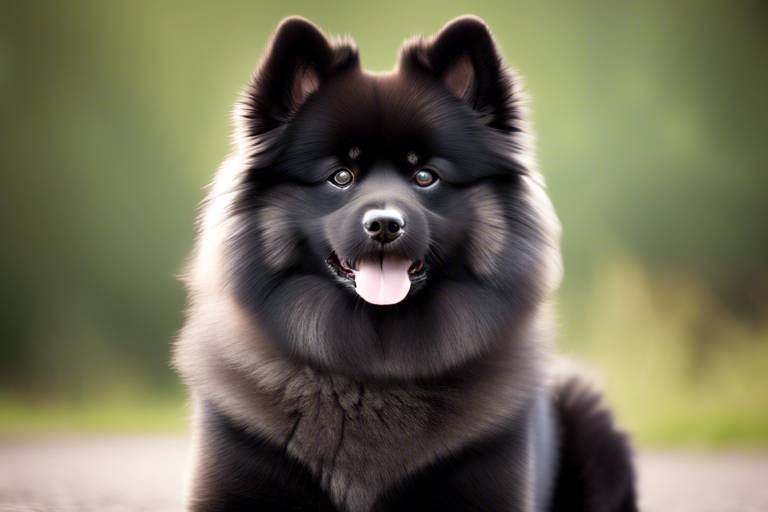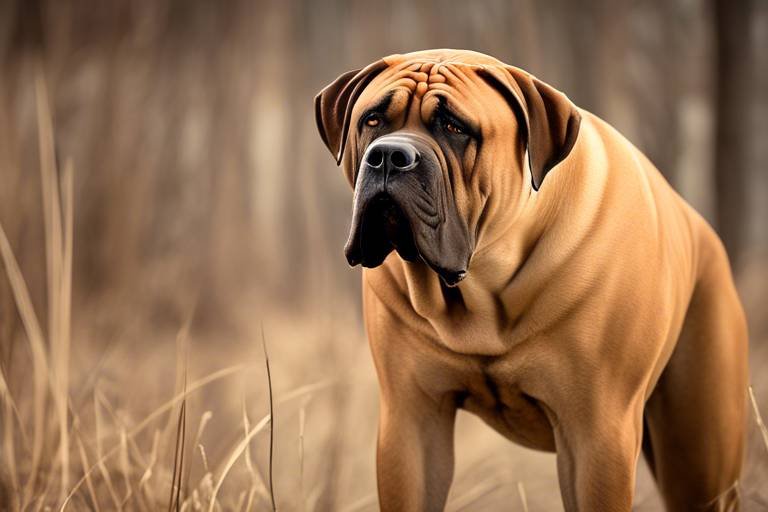The Unique Features of the American Bully
The American Bully is not just another dog breed; it’s a unique blend of strength, loyalty, and charm that sets it apart from the crowd. With its muscular physique and striking appearance, this breed has captured the hearts of many dog lovers around the world. But what truly makes the American Bully stand out? In this article, we will delve into the distinctive characteristics that define this remarkable breed, exploring its physical traits, temperament, and care requirements. Whether you're a potential owner or simply a dog enthusiast, understanding these features will give you a deeper appreciation for the American Bully.
When you first lay eyes on an American Bully, it’s hard to ignore its imposing stature and confident demeanor. These dogs are known for their muscular build, which is a result of selective breeding aimed at enhancing their physical prowess. Typically, American Bullies range from 30 to 120 pounds, depending on their specific type, and stand about 13 to 21 inches tall at the shoulder. Their broad head, pronounced cheek muscles, and strong jaws give them a distinctive look that many find appealing.
Another fascinating aspect of the American Bully is its coat. While the breed can come in a variety of colors, including black, blue, fawn, and brindle, the coat is generally short and smooth, requiring minimal grooming. This means less time spent on maintenance and more time enjoying the company of your furry friend. The combination of their physical attributes creates a striking appearance that is sure to turn heads wherever they go.
When it comes to temperament, the American Bully is often described as friendly, loyal, and affectionate. Despite their tough exterior, these dogs have a heart of gold and are known to form strong bonds with their families. They are incredibly social animals, thriving on interaction with their human companions and other pets. This breed is often misunderstood due to its appearance, but those who take the time to get to know them will find that American Bullies are gentle giants.
To ensure that your American Bully develops into a well-rounded adult, socialization is crucial. Exposing them to various environments, people, and other animals from a young age helps them build confidence and reduces the risk of behavioral issues later on. Effective socialization practices can include:
- Taking them to dog parks
- Introducing them to different types of people
- Engaging in puppy classes
These experiences will not only help your Bully become more adaptable but also foster a friendly disposition towards others.
One of the most endearing qualities of the American Bully is its ability to interact with children. Known for their protective instincts and playful nature, these dogs often form strong bonds with kids. They are patient and gentle, making them excellent companions for families. However, it’s essential to supervise interactions between dogs and young children to ensure a safe and enjoyable experience for everyone involved.
American Bullies can coexist harmoniously with other pets, including dogs and cats, especially when socialized early. Their friendly demeanor allows them to adapt to various living situations, but like any breed, individual personalities can vary. Early socialization plays a significant role in how well they will get along with other animals, so it's important to introduce them gradually and positively.
Training is a vital component of owning an American Bully. These dogs are intelligent and eager to please, making them relatively easy to train. However, consistency and positive reinforcement are key. Using treats, praise, and playtime as rewards can significantly enhance their learning experience. Establishing clear rules and boundaries from the start will help your Bully understand what is expected of them, leading to a well-behaved and happy companion.
Like all breeds, American Bullies are susceptible to certain health issues. Common concerns include hip dysplasia, skin allergies, and heart problems. Regular veterinary check-ups and preventive care are essential to ensuring your dog remains healthy. Owners should also be aware of the breed's predisposition to certain conditions and take proactive measures to maintain their well-being.
Proper nutrition is crucial for maintaining the health of an American Bully. A balanced diet tailored to their age, size, and activity level will support their growth and overall health. High-quality dog food that lists meat as the first ingredient is typically recommended. It's important to consult with your veterinarian to determine the best dietary plan for your specific dog.
American Bullies are energetic dogs that require regular exercise to stay healthy and happy. Daily walks, playtime, and interactive games are excellent ways to keep them physically and mentally stimulated. Engaging in activities such as agility training or obedience classes can also provide the necessary exercise while strengthening the bond between you and your dog.
Q: Are American Bullies good with children?
A: Yes, they are known for their friendly and protective nature, making them great companions for families.
Q: How much exercise do American Bullies need?
A: They require regular exercise, including daily walks and playtime, to maintain their health and energy levels.
Q: What are common health issues in American Bullies?
A: Common concerns include hip dysplasia, skin allergies, and heart problems. Regular vet visits are important for preventive care.
Q: How should I train my American Bully?
A: Consistency and positive reinforcement are key. Use treats and praise to encourage good behavior.

Physical Characteristics
The American Bully is a breed that truly stands out, not just in personality but also in its striking physical traits. One of the most noticeable features of this breed is its muscular build. With a wide chest and powerful limbs, the American Bully exudes strength and confidence. They typically weigh between 70 to 120 pounds, depending on the specific type and gender, which gives them a robust appearance that is both intimidating and endearing at the same time.
When it comes to size, American Bullies can vary significantly. Generally, they are classified into four categories based on their height and weight:
| Category | Height | Weight |
|---|---|---|
| Standard | 17-20 inches | 70-90 lbs |
| Classic | 17-20 inches | 70-90 lbs |
| 14-17 inches | 60-80 lbs | |
| Xl | 20-23 inches | 90-120 lbs |
Their heads are broad and square-shaped, with a pronounced stop, giving them an imposing look. The muzzle is short and wide, contributing to their powerful appearance. One of the breed's most charming features is its expressive eyes, which can be round or almond-shaped, often reflecting their gentle and friendly nature. The coat of an American Bully is another highlight; it is short, smooth, and comes in a variety of colors and patterns. Common coat colors include:
- Brindle
- Fawn
- Black
- Blue
- Chocolate
This variety allows for a unique aesthetic appeal that many dog lovers appreciate. Additionally, the breed's skin is thick and tight, which helps to prevent injuries and protects them in various environments. Overall, the American Bully's physical characteristics not only make them a stunning breed but also reflect their strong and loyal personality.

Temperament and Behavior
The American Bully is often celebrated for its exceptional temperament, making it a beloved choice for families and individuals alike. These dogs are known for their friendly nature and loyalty, which can sometimes surprise those unfamiliar with the breed. Unlike the stereotypical image of a tough dog, the American Bully is more like a gentle giant, bursting with affection and warmth. They thrive on human interaction and are eager to please, which makes them fantastic companions.
One of the most striking aspects of the American Bully's behavior is its ability to bond deeply with its family. They are protective yet playful, often forming strong attachments to their owners. This breed is not just a pet; they become part of the family. They love to participate in family activities, whether it's a casual evening on the couch or an outdoor adventure. Their playful nature and enthusiasm for life can turn even the most mundane day into an exciting event.
To ensure that an American Bully develops into a well-rounded adult, socialization is crucial. From a young age, these dogs should be exposed to a variety of people, environments, and other animals. This exposure helps them learn appropriate behaviors and reduces the likelihood of developing any behavioral issues. Positive experiences during their formative months can lead to a confident and well-adjusted dog. Think of socialization as a toolbox; the more tools you have, the better equipped your dog will be to handle different situations.
When it comes to kids, American Bullies are often the ultimate playmates. Their natural instinct to protect makes them particularly suited for families with children. They are gentle and patient, often displaying an incredible amount of tolerance during playtime. Many parents find comfort in knowing that their American Bully will look out for their little ones. However, it's important to remember that supervision is key during interactions to ensure both the dog and the child are safe and having fun.
American Bullies can also be great with other pets, including dogs and cats, especially if they are socialized early. It's essential to introduce them to different animals in a controlled environment to foster positive relationships. Just like humans, dogs have their own personalities, and some American Bullies may take longer to warm up to other pets. However, with the right approach and patience, they can coexist peacefully. Think of it as introducing a new friend; it may take time, but the rewards are worth it.
Training is another vital aspect of owning an American Bully. These dogs are intelligent and eager to learn, which makes them relatively easy to train. However, consistency and positive reinforcement are key. Using treats, praise, and playtime as rewards can motivate your Bully to follow commands and learn new tricks. Imagine teaching your dog to fetch; the joy on their face when they succeed is priceless. It's this kind of interaction that strengthens the bond between you and your dog.
- Are American Bullies aggressive? - No, when properly socialized, American Bullies are friendly and loyal.
- How much exercise do they need? - Regular exercise is crucial; aim for at least 30-60 minutes daily.
- Can they live in apartments? - Yes, but they require ample exercise and mental stimulation.
- What is their lifespan? - American Bullies typically live between 10 to 15 years.
Socialization Needs
The American Bully is a breed that thrives on social interaction. It's crucial for potential owners to understand the importance of socialization in developing these dogs into well-rounded companions. From an early age, exposing your American Bully to different environments, people, and other animals is essential. Think of socialization as the foundation of a house; without a solid base, everything else can crumble. The more varied experiences your Bully has, the more adaptable and confident they will become.
When socializing your American Bully, consider incorporating a variety of activities and settings. For instance, take them to parks, pet-friendly stores, or even doggy daycare. These experiences not only help them learn to interact with other dogs but also teach them how to behave in different situations. Imagine a child learning to ride a bike; the more they practice, the better they get. Similarly, the more your Bully interacts with the world around them, the more comfortable and well-behaved they will be.
It's also essential to introduce your American Bully to different types of people. This includes individuals of various ages, sizes, and backgrounds. By doing so, your dog will learn to be friendly and approachable, rather than fearful or aggressive. Remember, a well-socialized dog is a happy dog! To help you get started, here are some key socialization practices:
- Start Early: Begin socializing your Bully as a puppy, ideally between 3 to 14 weeks of age.
- Positive Reinforcement: Use treats and praise to reward good behavior during social interactions.
- Gradual Exposure: Slowly introduce your Bully to new experiences to prevent overwhelming them.
- Consistency is Key: Regularly expose your dog to new people and environments to reinforce their social skills.
In addition to these practices, consider enrolling your American Bully in obedience classes. These classes provide structured environments where your dog can learn essential commands while interacting with other dogs and people. It's a win-win situation; your Bully gets to socialize, and you gain valuable training skills. Think of it as a fun school where both you and your dog can learn together!
Ultimately, socialization is not just a one-time event; it's a lifelong commitment. Regularly exposing your American Bully to new experiences will help them develop into a well-adjusted, confident dog. So, get out there, have fun, and watch your Bully blossom into the amazing companion they are meant to be!
Interactions with Children
The American Bully is often celebrated for its gentle demeanor and playful spirit, making it a fantastic companion for children. These dogs are not just muscular and robust; they also possess a heart of gold. Their protective instincts kick in when they sense a child is in need, and they are known to form strong bonds with the little ones in their families. Picture this: a child laughing and running around, while an American Bully playfully trots alongside, tail wagging and eyes sparkling with enthusiasm. It's a beautiful sight that exemplifies the breed's affectionate nature.
One of the remarkable aspects of American Bullies is their ability to adapt to the energy levels of children. Whether it’s a quiet afternoon of cuddling on the couch or an energetic game of fetch in the yard, these dogs are ready to join in. They often exhibit a playful side that can turn any mundane day into an adventure. However, it's essential to remember that supervision is key. While American Bullies are generally patient and tolerant, young children may not always understand how to interact appropriately with dogs. Teaching kids to respect the dog's space and feelings can create a harmonious environment.
Moreover, socialization plays a crucial role in how American Bullies interact with kids. Early exposure to children of various ages can help them learn to navigate different situations and behaviors. This is where responsible pet ownership comes into play. By taking the time to introduce your puppy to children in a controlled manner, you can set the stage for a lifelong friendship. It's worth noting that American Bullies can be quite sensitive; they thrive on positive interactions and encouragement. So, when they receive love and gentle guidance, they often respond with loyalty and affection.
In terms of safety, American Bullies are often misunderstood. Many people mistakenly associate their muscular build with aggression. In reality, when properly socialized and trained, they are incredibly gentle giants. They have a natural instinct to protect their family, which includes the children. This protective nature can be a comforting presence for parents, knowing that their child has a devoted companion by their side. However, it’s crucial to teach children how to engage with the dog, ensuring that interactions remain positive and safe.
Here are a few tips for fostering positive interactions between American Bullies and children:
- Teach Respect: Educate children on how to approach and interact with dogs. Show them how to read the dog's body language.
- Supervise Playtime: Always supervise playtime between dogs and young children to prevent any accidental injuries.
- Encourage Gentle Touch: Teach kids to pet the dog gently and avoid pulling on ears or tails.
- Positive Reinforcement: Reward both the child and the dog for good behavior during their interactions.
In conclusion, the American Bully can be an incredible addition to families with children. Their friendly nature, coupled with their loyalty and protective instincts, makes them not just pets but family members. With proper training, socialization, and supervision, they can thrive in a household filled with laughter and love, creating memories that will last a lifetime.
- Are American Bullies good with children? Yes, American Bullies are known for their gentle nature and can be great companions for kids when properly trained and socialized.
- How should I introduce my American Bully to my children? Start with supervised interactions and teach your children how to approach and respect the dog.
- Can American Bullies be aggressive? While any dog can show aggression if not trained properly, American Bullies are typically gentle and protective when socialized correctly.
Compatibility with Other Pets
The American Bully is often misunderstood when it comes to their compatibility with other pets. Many people assume that their muscular stature and strong build make them aggressive, but that couldn't be further from the truth. In reality, American Bullies can be quite sociable and friendly, especially when they are properly socialized from a young age. Just like humans, dogs have their own personalities, and while some may be more dominant, others can be very gentle and accepting of other animals.
When introducing an American Bully to other pets, especially dogs and cats, it’s crucial to consider a few key factors. First, early socialization plays a significant role in how well they will adapt to living with other animals. Exposing them to various pets during their formative months can help them develop a friendly demeanor. This is akin to teaching a child to share and play nicely with others; the earlier the lessons begin, the better the outcomes.
Moreover, the temperament of the other pets is equally important. A calm and confident dog is more likely to get along with an American Bully than a nervous or aggressive one. When introducing your Bully to a new pet, it's wise to do so in a neutral environment where neither animal feels territorial. This can help reduce any potential stress or anxiety. Here are some tips for ensuring a smooth introduction:
- Start with short, supervised meetings, gradually increasing the time as they become more comfortable.
- Use positive reinforcement to reward good behavior during interactions.
- Monitor body language closely; signs of stress or aggression should be addressed immediately.
In many cases, American Bullies can form strong bonds with other pets, including cats. They often exhibit a playful nature, which can lead to delightful interactions. However, it’s essential to remember that not all Bullies will have the same level of tolerance or interest in other animals. Some may prefer the company of humans above all else. Therefore, each pet's personality should be taken into account when fostering a multi-pet household.
Ultimately, patience and consistent training are key. If you’re considering adding an American Bully to your home where other pets already reside, take the time to prepare both your new dog and your existing pets. With the right approach, you can create a harmonious household where all your furry friends coexist happily. Just like a well-conducted orchestra, each pet can play its unique part, contributing to a beautiful symphony of companionship.
Q: Are American Bullies good with cats?
A: Yes, many American Bullies can get along well with cats if they are introduced properly and socialized early. However, individual personalities may vary.
Q: How can I ensure my American Bully gets along with other dogs?
A: Start with controlled introductions in a neutral space, use positive reinforcement, and monitor their interactions closely to foster a positive relationship.
Q: What if my American Bully shows aggression towards other pets?
A: If aggression occurs, it’s important to seek help from a professional dog trainer or behaviorist who can provide guidance tailored to your specific situation.
Training Requirements
Training an American Bully is not just a necessity; it's a rewarding journey that strengthens the bond between you and your furry friend. These dogs are intelligent and eager to please, which makes them relatively easy to train. However, to ensure they grow into well-mannered adults, it’s essential to start training early. Think of it as laying the foundation for a sturdy house; without a solid base, everything else can crumble.
Consistency is key. Just like a musician practices their scales daily, your American Bully needs regular training sessions to grasp commands and behaviors. Aim for short, engaging sessions that last around 10 to 15 minutes, focusing on one command at a time. This approach keeps their attention and avoids overwhelming them. Remember, patience is a virtue! If they don’t get it right away, don’t fret. Use positive reinforcement techniques, such as treats or praise, to motivate them. Just as we all appreciate a little encouragement, your Bully will thrive on it.
When training, it’s also beneficial to incorporate various commands. Here are some fundamental commands that every American Bully should learn:
- Sit: A basic command that helps establish control.
- Stay: Crucial for safety and impulse control.
- Come: Essential for recall, especially in off-leash situations.
- Leave it: Important for preventing them from picking up harmful items.
Another important aspect of training is socialization. Exposing your American Bully to different environments, people, and other animals helps them become well-adjusted adults. Think of socialization as a buffet of experiences; the more they sample, the better their palate for life becomes. Start socializing them early, ideally between 3 to 14 weeks, when they are most receptive to new experiences. This will help them develop confidence and reduce the likelihood of fear-based behaviors later on.
Moreover, training should not just be about obedience; it should also be fun! Incorporate games that stimulate their minds and bodies. Activities like fetch or agility training can be both enjoyable and beneficial for their development. Just imagine how much fun it is for them to chase after a ball, their tails wagging with excitement! This not only keeps them physically active but also mentally engaged, which is crucial for their overall well-being.
In conclusion, training your American Bully is a multifaceted process that requires patience, consistency, and a lot of love. By investing time in proper training and socialization, you’re ensuring that your Bully grows up to be a well-behaved, confident, and happy companion. So grab those treats, get ready for some fun, and embark on this exciting training adventure!
Q: How early should I start training my American Bully?
A: It's best to start training as early as possible, ideally when they are puppies, around 8 weeks old. Early training helps instill good habits and behaviors.
Q: What is the best training method for American Bullies?
A: Positive reinforcement is the most effective training method. This includes rewarding good behavior with treats, praise, or playtime.
Q: How long should training sessions be?
A: Keep training sessions short, around 10-15 minutes, to maintain their attention and enthusiasm.
Q: Are American Bullies easy to train?
A: Yes, they are intelligent and eager to please, which makes them relatively easy to train, provided you use consistent and positive methods.

Health Considerations
The American Bully, like any other breed, has its own set of health considerations that potential owners should be aware of. Understanding these health issues is crucial for ensuring your furry friend leads a long, healthy life. While this breed is generally robust and muscular, there are specific health concerns that can affect them. It's essential to be proactive about their health and maintain regular veterinary check-ups to catch any potential issues early. Some common health problems include hip dysplasia, skin allergies, and heart conditions. By being informed, you can take the necessary steps to mitigate these risks and provide the best care possible.
One of the most prominent health issues in American Bullies is hip dysplasia. This genetic condition affects the hip joint, causing pain and mobility issues. It's often exacerbated by obesity, so maintaining a healthy weight is vital. Regular exercise and a balanced diet can significantly reduce the risk of developing this condition. Additionally, skin allergies are common in this breed, often resulting from environmental factors or certain foods. Owners should be vigilant for signs like excessive scratching or hot spots, which can indicate an allergic reaction.
Another health concern is cardiovascular issues, particularly heart disease. These problems can arise from genetics or lifestyle factors, such as lack of exercise and poor diet. To combat this, it's critical to provide your American Bully with a well-rounded diet rich in essential nutrients, as well as regular physical activity. Below is a table summarizing some of the common health issues associated with American Bullies:
| Health Issue | Description | Prevention |
|---|---|---|
| Hip Dysplasia | A genetic condition affecting the hip joint. | Maintain a healthy weight and regular exercise. |
| Skin Allergies | Reactions to environmental factors or food. | Monitor for symptoms and consult a vet for allergy testing. |
| Heart Disease | Cardiovascular issues that can lead to serious health problems. | Provide a balanced diet and regular exercise. |
In addition to these common issues, it's crucial to pay attention to your American Bully's nutrition and diet. A proper diet not only helps in maintaining a healthy weight but also supports overall health. High-quality dog food that lists meat as the first ingredient is often recommended. Be cautious of feeding them table scraps or low-quality foods, as this can lead to obesity and other health problems. It's also advisable to consult with your veterinarian about the best dietary plan suited for your dog's specific needs.
Lastly, regular exercise is essential for the American Bully's physical and mental well-being. These dogs are energetic and require a good amount of daily activity to stay healthy. Activities such as walking, running, and playing fetch can help keep them fit. Not only does this prevent obesity, but it also provides necessary mental stimulation, which is just as important for their overall health.
- What is the average lifespan of an American Bully? The average lifespan ranges from 10 to 15 years, depending on genetics and care.
- Are American Bullies prone to any specific diseases? Yes, they can be prone to hip dysplasia, skin allergies, and heart conditions.
- How often should I take my American Bully to the vet? Regular check-ups every 6 to 12 months are recommended to monitor their health.
- What should I feed my American Bully? A high-quality diet rich in protein and essential nutrients is best; consult your vet for specific recommendations.
Nutrition and Diet
The nutrition and diet of an American Bully are crucial to their overall health and well-being. These dogs are muscular and active, which means they require a balanced diet that supports their energy levels and maintains their muscle mass. A typical American Bully thrives on high-quality dog food that is rich in protein, as this is essential for their muscle development. Look for foods that list meat as the first ingredient, such as chicken, beef, or fish, to ensure they are getting the nutrients they need.
When considering the right diet for your American Bully, it's important to pay attention to their age, weight, and activity level. Puppies, adults, and seniors have different nutritional needs. For instance, puppies require more calories and nutrients to support their rapid growth, while senior dogs may need a diet lower in calories to prevent obesity. Here’s a quick breakdown of dietary needs based on life stages:
| Life Stage | Dietary Needs |
|---|---|
| Puppy | High protein, high calories, DHA for brain development |
| Adult | Moderate protein, balanced nutrients, regular feeding schedule |
| Senior | Lower calories, joint support supplements, easier-to-digest food |
In addition to protein, American Bullies also need a mix of healthy fats and carbohydrates. Fats are essential for energy and help maintain a healthy coat, while carbohydrates provide the necessary fuel for their active lifestyle. Look for dog foods that include whole grains, fruits, and vegetables, which can provide essential vitamins and minerals.
Another important aspect of your American Bully's diet is the feeding schedule. It's typically recommended to feed adult dogs twice a day to maintain their energy levels and prevent overeating. Puppies, on the other hand, may require three to four meals a day due to their higher energy needs. Always ensure that fresh water is available at all times to keep your dog hydrated.
Lastly, be cautious with treats. While it's tempting to spoil your furry friend with snacks, moderation is key. Opt for healthy treats that are low in calories and made from natural ingredients. This not only helps in maintaining a healthy weight but also reinforces good behavior during training sessions.
In conclusion, providing a well-balanced diet for your American Bully is not just about filling their bowl; it's about ensuring they lead a healthy and active life. By focusing on high-quality ingredients, appropriate feeding schedules, and proper portion sizes, you'll set your beloved companion up for a vibrant and energetic lifestyle.
- What is the best food for an American Bully? Look for high-quality dog food that lists meat as the first ingredient and is appropriate for their life stage.
- How often should I feed my American Bully? Adult American Bullies should be fed twice a day, while puppies may need three to four meals.
- Can I give my American Bully table scraps? It's best to avoid table scraps as they can lead to obesity and digestive issues. Stick to dog-friendly treats.
- How can I ensure my American Bully is getting enough nutrients? Regular veterinary check-ups can help assess your dog's health and dietary needs.
Exercise and Activity Levels
The American Bully is not just a pretty face; this breed is bursting with energy and enthusiasm! To keep your furry friend happy and healthy, it's essential to provide them with adequate exercise and mental stimulation. Think of their exercise needs like a well-balanced diet—if you don't feed them the right amount of physical activity, they may become restless or develop behavioral issues. So, how much exercise do they need? Generally, an American Bully requires at least 30 to 60 minutes of exercise per day, depending on their age, health, and energy levels. This can include walks, playtime, and even some fun training sessions!
One of the best ways to ensure your American Bully gets the right amount of exercise is to mix it up! A monotonous routine can lead to boredom, and we all know what that means—trouble! Engage them in various activities, such as:
- Long walks in the park
- Interactive games like fetch or tug-of-war
- Agility training to challenge their minds and bodies
- Swimming, which is a fantastic low-impact workout
In addition to physical exercise, mental stimulation is equally important. American Bullies are intelligent dogs, and they thrive when their brains are engaged. Puzzle toys, training exercises, or simply teaching them new tricks can keep their minds sharp and focused. Remember, a tired dog is a happy dog!
Moreover, it’s crucial to consider the weather when planning your exercise schedule. During hot summer days, opt for early morning or late evening walks to avoid overheating. Conversely, in colder months, make sure your Bully is adequately protected from the chill. Their short coat doesn’t provide much insulation, so a cozy doggy sweater can be a smart investment!
Lastly, always monitor your American Bully during exercise. Look out for signs of fatigue or overheating, such as excessive panting or drooling. Hydration is key, so have fresh water available at all times. By keeping these factors in mind, you can ensure that your American Bully leads a vibrant and active life, filled with joy and companionship.
Q: How much exercise does an American Bully need?
A: An American Bully typically requires at least 30 to 60 minutes of exercise each day, which can include walks, playtime, and training activities.
Q: Can American Bullies swim?
A: Yes, many American Bullies enjoy swimming! It's a great low-impact exercise that can help keep them cool and fit.
Q: What are some good activities for an American Bully?
A: Activities can range from long walks, fetch games, agility training, to mental challenges like puzzle toys and trick training.
Q: How do I know if my American Bully is getting enough exercise?
A: Signs of a well-exercised dog include a calm demeanor, good behavior, and a healthy weight. If your Bully is restless or destructive, they may need more activity.
Frequently Asked Questions
- What are the physical characteristics of the American Bully?
The American Bully is known for its muscular build and broad head. They typically have a strong, stocky body with a wide chest and thick neck. Their coat can come in various colors, including brindle, fawn, and blue. Overall, their appearance is both imposing and attractive, making them stand out in any setting.
- How is the temperament of the American Bully?
This breed is generally friendly and loyal, making them excellent companions. They are known for their playful nature and are often very affectionate with their families. With proper socialization, they can be great with children and other pets, showcasing their gentle side despite their tough exterior.
- What are the socialization needs of an American Bully?
Socialization is crucial for American Bullies to develop positive behaviors. Early exposure to different environments, people, and other animals helps them become well-adjusted adults. Regular interactions can prevent behavioral issues and promote a balanced temperament.
- Are American Bullies good with children?
Absolutely! American Bullies are often known for their protective instincts and playful demeanor around kids. They can be very gentle and loving, making them suitable family pets. However, supervision during playtime is always a good idea to ensure safety for both the dog and the children.
- Can American Bullies get along with other pets?
Yes, with proper socialization, American Bullies can coexist peacefully with other pets, including dogs and cats. Early introductions and positive reinforcement can foster friendliness and reduce the likelihood of conflicts, allowing them to thrive in multi-pet households.
- What are the training requirements for American Bullies?
Training is essential for American Bullies to ensure they develop good behavior. Using positive reinforcement techniques and being consistent with commands can lead to successful training outcomes. They are intelligent dogs and respond well to structured training sessions.
- What health considerations should I be aware of with American Bullies?
Like all breeds, American Bullies have specific health concerns, including hip dysplasia and skin issues. Regular veterinary check-ups, a balanced diet, and proper exercise are vital to maintaining their health and preventing potential problems.
- What should I feed my American Bully?
Proper nutrition is key to keeping your American Bully healthy. A high-quality dog food that meets their dietary needs is essential. It's best to consult with a veterinarian for specific recommendations based on their age, weight, and activity level.
- How much exercise do American Bullies need?
American Bullies require regular exercise to stay healthy and happy. Daily walks, playtime, and mental stimulation through training or puzzle toys can help keep them physically and mentally fit. A well-exercised Bully is a content Bully!



















